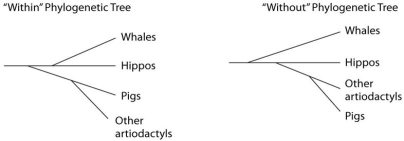Use the following information and figure to answer the questions below.
Traditionally, whales and hippopotamuses have been classified in different orders, the Cetacea and the Artiodactyla, respectively. Recent molecular evidence, however, indicates that the whales' closest living relatives are the hippos. This has caused some zoologists to lump the two orders together into a single clade, the Cetartiodactyla. There is no consensus on whether the Cetartiodactyla should be accorded order status or superorder status. This is because it remains unclear whether the whale lineage diverged from the lineage leading to the hippos before or after the other members of the order Artiodactyla (pigs, camels, etc.) diverged (see the figure below) .

This figure contrasts the "Within the artiodactyls" origin of the whale lineage with the "Without the artiodactyls" origin of the whale lineage.
-Placing whales and hippos in the same clade means
A) that these organisms are phenotypically more similar to each other than to any others shown on the trees in the above figure.
B) that their morphological similarities are probably homoplasies.
C) that they had a common ancestor.
D) that all three of the responses are correct.
E) that two of the responses are correct.
Correct Answer:
Verified
Q32: Which eukaryotic kingdom is polyphyletic, and therefore
Q39: Which kingdom has been replaced with two
Q47: A) that these organisms are phenotypically more
Q48: What can be properly inferred from the
Q49: The following questions refer to this phylogenetic
Q52: Which of the following items does not
Q53: A) that these organisms are phenotypically more
Q55: Use this figure to answer the following
Q56: The following questions refer to this phylogenetic
Q57: A) that these organisms are phenotypically more
Unlock this Answer For Free Now!
View this answer and more for free by performing one of the following actions

Scan the QR code to install the App and get 2 free unlocks

Unlock quizzes for free by uploading documents